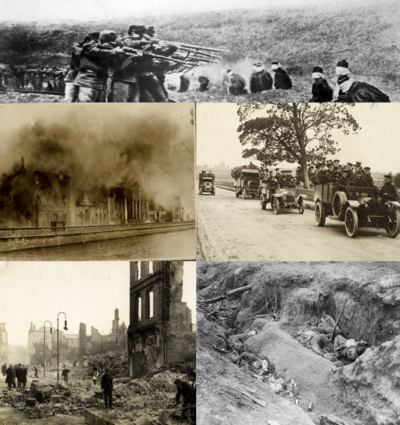Second Gjorkan Civil War
| Second Gjorkan Civil War | ||||||||
|---|---|---|---|---|---|---|---|---|
 (Clockwise from top) Execution of deserters by Loyalist Forces, Volunteers leaving to join the Revolutionary Fight, Captured Trench filled with dead Socialists, Ruins of Nomakoa following the capture of the city by Revolutionary Forces, Burning of the Gjorkan Royal Palace as Revolutionary and Loyalist Forces fight for control of Gjorkan City . | ||||||||
| ||||||||
| Belligerents | ||||||||
|
| |||||||
| Commanders and leaders | ||||||||
|
|
|
| ||||||
| Strength | ||||||||
| 2,100,000 Soldiers | 3,790,000 Soldiers | 575,00 Soldiers | ||||||
| Casualties and losses | ||||||||
|
575,000 Dead 985,000 Wounded |
1,389,000 Dead 200,000 Wounded |
310,000 Dead 100,000 Wounded | ||||||
The Second Gjorkan Civil War was an armed conflict in Gjorka fought between Loyal Government Forces, Revolutionaries and Socialists. The war started after the First Blue Revolution in which revolutionaries rioted and took control over Gjorkan City due to decades of corruption and repression by the Government.
After the success of the Blue Revolution, riots began exploding across the country as citizens marched to show their disdain for the Government. The High Council of Gjorka fled to Baltimore and began organizing Military units to suppress the revolution. The Loyalist Military was in chaos as units were facing mass desertions, and harassment from locals as they marched. Similar problems were faced by the revolutionaries as they attempted to set up a government. Volunteers and Recruits were flooding in from across the country, and fights were breaking out in the streets. Realizing if they remained disunited they would have no chance of winning, the Revolutionary Government in Gjorkan City negotiated a Government of Unity with the Socialist Government that had taken power in Nomakoa. Most early battles in the war were no more than skirmishes as both sides faced trouble with organization.
Once both sides began forming into cohesive armies the bloodshed began. The revolutionaries dwarfed their loyalist enemies in terms of manpower, but had almost no effective military commanders. The loyalists massacred hundreds of thousands of Revolutionaries in the first year of the war, handing them devastating loses. Even managing to capture Gjorkan City, and arrive at the outskirts of Nomakoa. However, a young military officer named Éamon de Valera took charge of the defense of Nomakoa after his general died. He won several battles against the loyalists and pushed them back from Nomakoa. His successes revitalized the revolutionary cause, and his rapid advances were threatening the Loyalist cause. Exhausting all options, the Loyalists began building a system of trenches to halt the Revolutionary assault. This tactic was extremely successful, and the Revolutionary advance completely stalled. This system of trench warfare lasted for the remainder of the war.
As the war dragged on, and casualties were piling up, dissent began to grow in cities under revolutionary control. In response to this Éamon de Valera, now Commander of the entire Revolutionary Forces, began to brutally crack down on these protests. Many of the protesters were pacifist socialist were decided to work in the factories rather than fight on the front. This suppression of their members, greatly angered the socialist bloc of the Unity Government. As tensions mounted, the Bloc announced their withdrawl from the Unity Government, and formed their own. From 1917 onward, the civil war was fought between three sides: the Socialists, Revolutionaries and Loyalists.
The Socialist Rebellion was actually the key to the Revolutionary Victory. The Socialist Commanders were incredibly aggressive and pushed hard against the Loyalists. This forced the Loyalists to devote more soldiers to the socialist front, and freed up space for a massive push. Valera ordered the massive attack, and after initial bogging down as troops were massacred attempting to push the trenches. However, soon the attacks began picking up steam. Revolutionary Forces had been fighting over Gjorkan City since the start of the war, but were able to finally re-capture the city. The Revolutionaries pushed north, and secured the coastline with the capture of Éire. Pushing inward the Loyalist forces began collapsing, and by January , a surrender was negotiated between the revolutionaries and the loyalists following the capture of Rusynia. Valera then ordered a complete destruction of socialist forces due to their treason. After month of bloody fighting, and the loss of most of the socialist army, the war ended on November 11th with the surrender of the last socialist forces in Nomakoa.